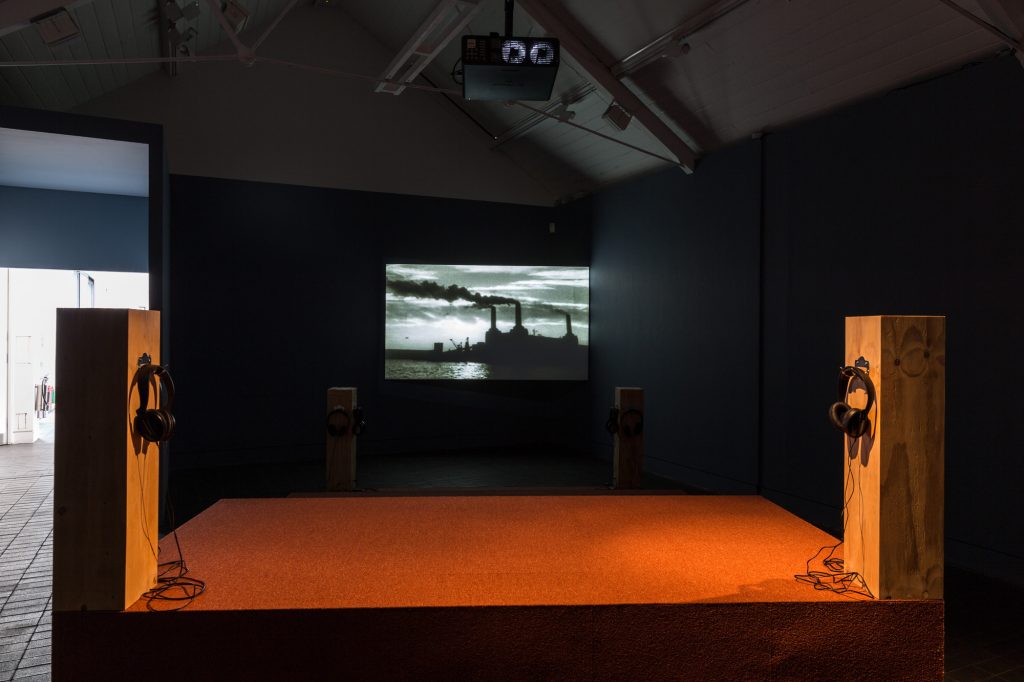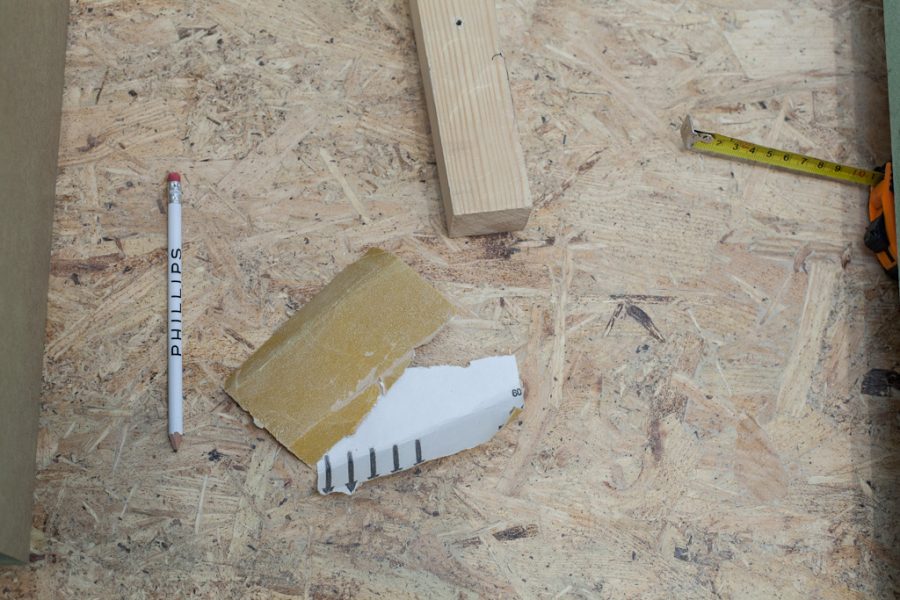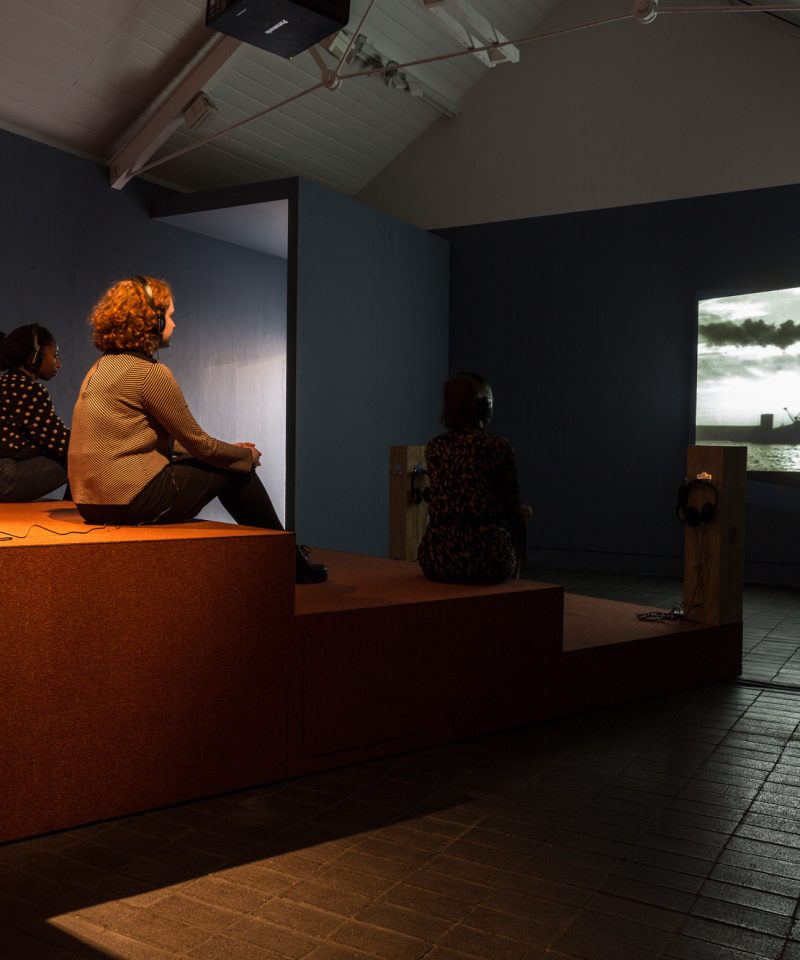Jerwood/FVU Awards 2016: ‘Borrowed Time’ is an exhibition of two moving image works: Dream City – More, Better, Sooner by Alice May Williams and The Eye That Articulates Belongs On Land by Karen Kramer, installed at Jerwood Space, London from 9 March to 24 April and at CCA, Glasgow from 28 May to 10 July 2016. I invited each artist to record a radio show with a view to focusing on their use of sound – the first discussion with Alice May Williams aired on Resonance FM on 12 April and considered the voiceover, the language of mindfulness, and the loop. Listen again via the player below, and read a tidied up extract of the notes that Alice and I exchanged in advance of our recording.
The voiceover in your film draws on the language of mindfulness, partly in order to deconstruct it and ask whether it’s really as good as it’s made out to be. You sent me a Guardian article, Dawn Foster’s ‘Is mindfulness making us ill?’, referring to ‘mandatory meditation’ in the workplace ‘as a route to heightened productivity, in tandem with various apps, wearable devices and forms of low-level employee surveillance’. One of my criticisms of the use of mindfulness in the workplace, and the translation of what should be freely accessible health services delivered by specialists into apps would be that it supposes that states of mind can be calculated, quantified, and easily set to the ‘correct’ or ‘healthy’ level. I also sent you a PDF of Lynne Friedli and Robert Stearn’s article ‘Positive affect as coercive strategy: conditionality, activation and the role of psychology in UK government workfare programmes,’ and you replied that you found it ‘terrifying, truly horrible’ to read.
Yes, I think the application of mindfulness by employers, as a way of encouraging workers to take individual responsibility, even blame, for their stress is very worrying. The use by the health services of mindfulness as a one size fits all response to mental health is also very tricky as there is a big difference, for example, between a person’s experiences of work related stress, someone who needs a break from their emails etc., and somebody who has a depressive illness. I was really interested in the workfare article you sent me; I find it particularly sad that people are now being penalised for not having the correct ‘positive feelings’ about finding a job, even as the actual difficult conditions of doing so point to their pessimism as being the more ‘correct’ response.

Did you feel wary about engaging with mindfulness in an artwork? I feel like mindfulness, as well as anxiety, depression, care and therapy are themes that are very much in the air at the moment.
I started scripting this work over a year ago when I was give a course of mindfulness for depression. I’d never heard of mindfulness before but it has since taken off! I had hoped that people would understand the type of language being used and the structure of the piece as being borrowed from mindfulness, and people have told me they felt a slightly uncanny recognition of some of the particular phrases in the film from their own experiences of the practice, realising there is perhaps a ‘scripted’ element which mindfulness teachers learn and repeat. I also wanted to use the structure of mindfulness practice in the film, but to ‘disobey’ it in a way, to continually divert away from the present moment, to recognise the importance of being able to understand the past, to be able to dream of futures. It is actually I think a condition of depression to be sort of stuck in an endless present, to be unable to imagine a different future, and so I wanted to offer something more hopeful than that.
To what extent is your drawing together of mindfulness, regeneration and financial speculation on property (the history of Battersea Power Station and its redevelopment) an attempt to suggest that the root of mental illness does not just reside in individual predisposition, peoples’ inability to cope, etc. but that it also comes from structures that force us to live in unhealthy ways? I re-read Sam Kriss’s review of the DSM 5 the other day and highlighted the following passage:
‘The idea emerges that every person’s illness is somehow their own fault, that it comes from nowhere but themselves: their genes, their addictions, and their inherent human insufficiency. We enter a strange shadow-world where for someone to engage in prostitution isn’t the result of intersecting environmental factors (gender relations, economic class, family and social relationships) but a symptom of “conduct disorder,” along with “lying, truancy, [and] running away.” A mad person is like a faulty machine.’
It chimes with what Hannah Black says in this conversation with Andrea Crespo: ‘It’s possible to conceive of most mental illnesses as finding it hard to hold down a job’. That’s what’s so awful, among other things, about the ‘shift from rest cure (signified by the sick note), to work cure (signified by the fit note)’ that Friedli and Stearn have identified in a context of austerity.
I think there is an element of truth to some mental health issues arising from the circumstances under which we are made to live but I also think that we can’t talk about these things in such universalising terms (as some applications of mindfulness as therapy for mental health are guilty of). Every one of us has a different set of circumstances and difficulties which can arise from a chemical imbalance as much as a capital one! I’m also wary of critical theory using the language of mental health to talk about wider, or more abstract concepts, or exoticising mental health conditions as ‘alternative ways of being’ – for example the art world’s fascination with the ideas of R. D. Laing. There’s a danger of theorising about mental health in relation to capitalism, which fails to acknowledge the very real painful experiences of people whose medical issues go beyond ‘the present moment’. I think Hannah Black’s writing about schizophrenia in ‘Crazy in Love’ is very good in this regard.

At the Artist’s Film Club screening event and talk at the ICA you referred to hope, saying that if you only focus on the present moment [as mindfulness asks us to] ‘you can’t really have any hope, you can’t project into the future. We can’t even begin to imagine 60 years into the future.’ You’ve also referred to hope above. But can we really be hopeful though? I sometimes think I’m more in favour of a something like ‘depressive realism’, as described in this interview with Lauren Berlant.
I like this part: ‘Depressive realism allows for an account of the utility of fantasy in maintaining but also imagining alternative modes of life.’ And I appreciate how Berlant talks about depressive realists understanding themselves as being at odds, fully aware of everything that is happening, and acknowledging everything that is difficult about staying in sync with the world. I think we can be hopeful though, by trying to understand history and the present moment within it as part of a much larger whole, by thinking in terms of the cyclical nature of change, over centuries rather than decades. I attempted in this film and in my previous work An Unreliable Witness to think in terms of my great-great grandmother’s life span of 95 years and what kind of potential long-term thought would open onto. I also think dreaming and inner life need to be preserved sites of hope, refusal, and parts of life escape ownership.




